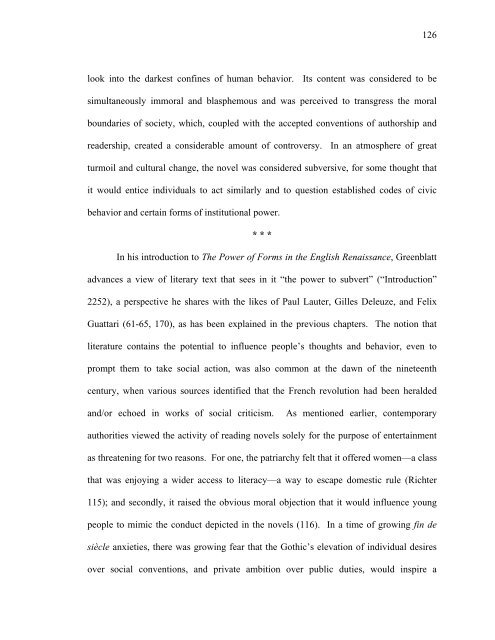Untitled - Sexey's School Moodle
Untitled - Sexey's School Moodle
Untitled - Sexey's School Moodle
Create successful ePaper yourself
Turn your PDF publications into a flip-book with our unique Google optimized e-Paper software.
look into the darkest confines of human behavior. Its content was considered to be<br />
simultaneously immoral and blasphemous and was perceived to transgress the moral<br />
boundaries of society, which, coupled with the accepted conventions of authorship and<br />
readership, created a considerable amount of controversy. In an atmosphere of great<br />
turmoil and cultural change, the novel was considered subversive, for some thought that<br />
it would entice individuals to act similarly and to question established codes of civic<br />
behavior and certain forms of institutional power.<br />
* * *<br />
126<br />
In his introduction to The Power of Forms in the English Renaissance, Greenblatt<br />
advances a view of literary text that sees in it “the power to subvert” (“Introduction”<br />
2252), a perspective he shares with the likes of Paul Lauter, Gilles Deleuze, and Felix<br />
Guattari (61-65, 170), as has been explained in the previous chapters. The notion that<br />
literature contains the potential to influence people’s thoughts and behavior, even to<br />
prompt them to take social action, was also common at the dawn of the nineteenth<br />
century, when various sources identified that the French revolution had been heralded<br />
and/or echoed in works of social criticism. As mentioned earlier, contemporary<br />
authorities viewed the activity of reading novels solely for the purpose of entertainment<br />
as threatening for two reasons. For one, the patriarchy felt that it offered women—a class<br />
that was enjoying a wider access to literacy—a way to escape domestic rule (Richter<br />
115); and secondly, it raised the obvious moral objection that it would influence young<br />
people to mimic the conduct depicted in the novels (116). In a time of growing fin de<br />
siècle anxieties, there was growing fear that the Gothic’s elevation of individual desires<br />
over social conventions, and private ambition over public duties, would inspire a



